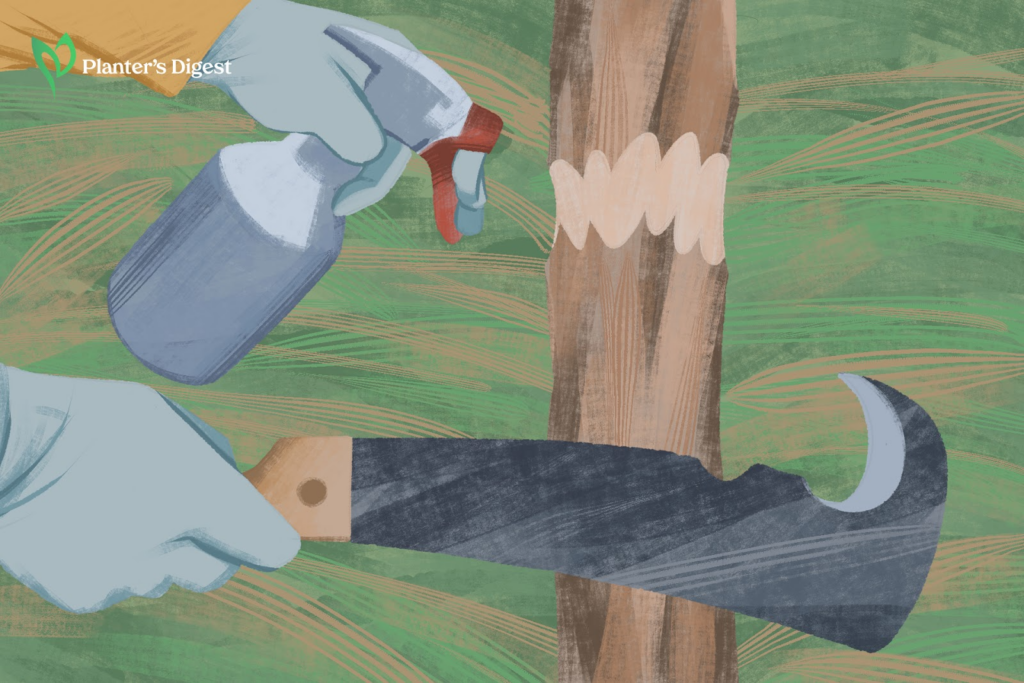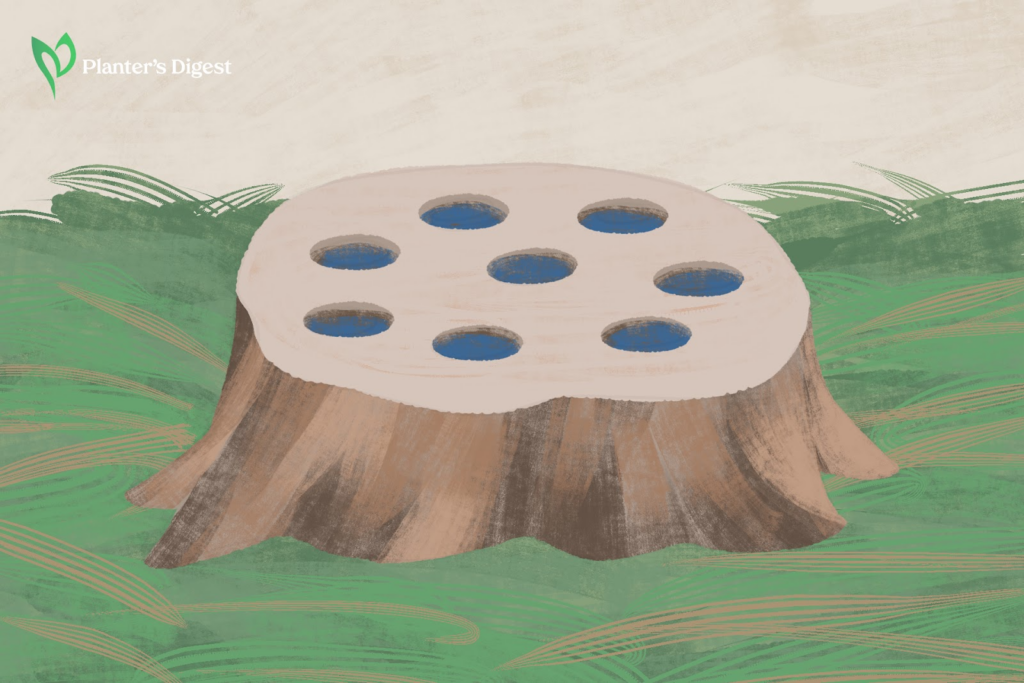
A well-known force to be reckoned with, 2,4-D is a gardener’s best friend and always a part of their arsenal when taking down virtually any non-grass plant.
Hence, it’s no surprise that it has piqued the curiosity of many if 2,4-D is strong enough to work on trees.
We’ve got the answer to your what, how, and why questions on the ability of 2,4-D to kill trees.
Will 2,4-D kill trees?

2,4-D can kill trees by causing the cells to grow uncontrollably. The non-stop cell division forces the tree to work double time, ultimately causing it to die of exhaustion.
In order for 2,4-D Amine to effectively kill your tree, it’s important to use the most appropriate application method.
For small to medium-sized trees, spraying the herbicide on the tree’s leaves is enough to work. Though, larger trees need to be cut to a stump and treated with the herbicide.
What is the difference between 2,4-D amine and ester?

2,4-D Amine has a low vapor pressure which reduces potency and volatility. Meanwhile, 2,4-D Ester has a high vapor pressure which makes it more potent, meaning it’s stronger and more effective.
Despite having different formulations, they’re both selective herbicides. This means that they’re known to work primarily on selected plants.
Even then, you’ll want to be careful when choosing which formulation to use, especially if you’d like to minimize the risk of any plant or crop casualties.
Since 2,4-D Amine is less volatile, it’s a better choice when applied to lawns, turfs, or weeds that are surrounded by vegetative crops or sensitive plants.
2,4-D Ester, on the other hand, has a more potent chemical structure, making it the more intense formulation of the two. As a result, it’s powerful enough to cause serious crop injuries, especially when not applied correctly.
Solubility is another vital factor to consider when choosing which formulation to use. Between the two, 2,4-D Ester does a better job at penetrating through the leaves than 2,4-D Amine.
This is because ester formulations are lipid-soluble, which means that they’re a lot easier to soak up than amine formulations. Since 2,4-D Amine formulations are water-soluble, they go through the plant’s cuticle at a slower pace.
Here’s a table presenting a side-by-side comparison of the different 2,4-D formulations:
| Formulation | Amine | Ester |
| Vapor Pressure | Low | High |
| Volatility | Low | High |
| Effectivity | Low | High |
| Solubility | Water soluble | Lipid soluble |
How does 2,4-D work?

2,4-D works by creating excess synthetic auxin, a natural growth hormone that’s responsible for regulating cell growth along with transporting water and nutrients.
Too much auxin will result in high levels of ethylene, free radicals, and ABA, which will cause the plant to overstimulate.
Another growth hormone, ethylene is in charge of the ripening process. Excessive amounts can cause stunted growth, discolored and deformed leaves, and death.
Large quantities of ethylene also contribute to the production of free radicals, which are lone electrons. Because they’re unpaired, they become highly unstable and create negative reactions when they bump into molecules within the plant.
As a result, they tend to wreak havoc on the cell and DNA composition of the plant. High levels of free radicals cause an abundance of stress, too.
In the same vein, excessive auxin causes the plant to release abscisic acid (ABA). This stress hormone causes the stomata to close, inhibiting the absorption of CO2, which it needs for photosynthesis.
Subsequently, the plant can’t create carbohydrates without any CO2 in its system. This causes an imbalance, which will cause the plant to die due to the lack of food.
Other than that, water can’t properly oxidize, keeping the electrons that are supposed to be removed with water. This causes even more free radicals to develop.
Your plant will try its best to fix and regulate its auxin levels, but it won’t be able to. In the end, it’ll tire itself out and eventually die of exhaustion.
How do I kill a tree with 2,4-D?

The best ways to kill a tree with 2,4-D are through the foliar spray method, cut surface treatment, or basal bark techniques.
The foliar spray method works best on younger and leafier trees. Meanwhile, the cut surface treatment and cut stump technique are more effective on large, mature trees.
If you’re curious about how to do each one, keep reading for easy-to-follow instructions.
But before that, be sure to wear personal protective equipment when handling any formulation of 2,4-D. This means wearing proper face covering, mask, and clothing that covers the skin.
1. Foliar Spray Method

| Difficulty | Easy ●●○○○ |
| Speed | Slow-acting |
| Things You Need | • Personal protective equipment • Backpack sprayer or spray bottle • Ladder (optional) • 2,4-D |
The foliar spray technique is rather self-explanatory. It involves simply spraying the leaves of the tree that you want to kill with an even and generous coating of 2,4-D.
Though it’s important to keep in mind that this method is the most effective on young trees that have bushy canopies. This is because it can penetrate through multiple entry points, boosting its chances of killing the tree off.
Otherwise, don’t expect to see any results, especially on large, mature trees. If you do use 2,4-D on these types of trees, you’re just wasting herbicide.
While 2,4-D is quite strong, it’s worth keeping an eye out on your progress to see if your tree needs another application.
Other than that, you may want to use a ladder and a backpack sprayer for an easier application process. It’ll also give you enough height to reach areas that are tricky to get to.
You’ll also want to strictly monitor the weather forecast on the day you plan to treat your tree with 2,4-D and the days after. This is because poor weather conditions can cause casualties.
Wind will make it difficult to apply an even coating of 2,4-D because it’ll just be blown away to nearby plants. Meanwhile, rain will wash off the herbicide.
| How To Do 1. Cover any nearby plants that you don’t want to get 2,4-D on. Even though 2,4-D is a selective herbicide, it’s still recommended to protect nearby plants that could get accidentally damaged. 2. Prepare your 2,4-D solution. There may be preparatory steps depending on the kind of formulation and concentration of your 2,4-D. Some varieties may require dilution while others come in a low-concentrated, ready-to-use mix. While you’re at it, be sure to properly read through the instructions to avoid any mishaps. 3. Apply a generous, even coat of 2,4-D on the leaves of your tree, starting from the crown and slowly working your way downward. Starting the application from the top of the tree’s canopy ensures that excess herbicide will fall onto the leaves at the bottom, preventing wastage. When applying, be sure to spread an even amount onto the foliage. Be careful not to put too much as you don’t want the excess dripping. Depending on the hardiness of your tree, you may need to apply more than one coat. Before your second application, make sure that the first coat has completely dried first. 4. Pay attention to any signs of deterioration. In most cases, you’ll be able to spot observable signs of deterioration within the first 48 hours after application. 4. Though since 2,4-D is a relatively slow-acting chemical herbicide, full results won’t be seen until about 10 to 20 days after application. 5. Remove the dead tree from your property Once you’re certain that your tree has died, you can remove it by chopping it into smaller pieces and then digging the stump out. Alternatively, you can call your local arborist to get the tree professionally removed. |
2. Cut Surface Treatments

| Difficulty | Moderate – Hard ●●●●○ |
| Speed | Slow-acting |
| Things You Need | • Personal protective equipment • Power drill, hatchet, or ax • Heavy-duty plastic sheet • 2,4-D |
For mature trees, the best course of action would be to perform the cut surface treatment.
This is primarily because simply spraying 2,4-D onto the tree’s foliage won’t be enough for such a large and well-established tree. As a result, you’ll need to bring in the big guns, if you will!
As the name suggests, this method involves making several 45-degree angled slashes through your tree’s bark. These will need to be a couple of inches deep to ensure that the herbicide penetrates deeply into the tree’s layers.
Alternatively, you can also use a power drill to create several 45-degree angled holes through the bark.
You can add multiple slashes or holes that are spaced 10 cm apart from one another.
Compared to the other methods, the cut surface treatment is a bit harder to do since penetrating through a tree bark is no joke. It’s pretty hard and will definitely count as a workout.
Other than that, this treatment is limited to being done only during the tree’s active growth period. This is because this timeframe, around late spring to summer, ensures the highest level of effectiveness.
It’s also worth highlighting that this method takes a bit longer than the others, taking about 1 to 6 weeks to fully take effect.
| How To Do 1. Prepare your 2,4-D solution as directed by the label’s instructions. Depending on the formulation and concentration of your 2,4-D solution, you may need to do several preparatory steps. Some types with higher concentrations need to be diluted while others are ready-to-use. Don’t forget to thoroughly go through the instructions to prevent any accidents. 2. Use your hatchet, power drill, or ax to create a 45-degree angled cut or hole through the bark about 2 to 3 inches deep. It’s vital that your incision is at a 45-degree angle as this will act as a makeshift basin to hold the herbicide while the tree takes its time absorbing it. 3. Pour a liberal amount of 2,4-D onto the freshly made cuts or holes. To ensure effectiveness, you need to apply the herbicide immediately after creating the cut or hole. 4. Cover the cut or hole with a heavy-duty plastic sheet. This will ensure that your incision isn’t exposed to the elements, giving the tree enough time for optimal absorption. 5. Repeat steps #2 to #4. Continue to make your way around the tree, creating cuts or holes then applying 2,4-D. Make several cuts or holes around the bark, branches, and exposed roots about 10 cm apart from one another. 6. Pay attention to any signs of deterioration. In most cases, you’ll be able to spot observable signs of deterioration within the first 48 hours after application. Though since 2,4-D is a relatively slow-acting chemical herbicide, full results won’t be seen until about 10 to 20 days after application. 7. Remove the dead tree from your property Once you’re certain that your tree has died, you can remove it by chopping it into smaller pieces and then digging the stump out. Alternatively, you can call your local arborist to get the tree professionally removed. |
3. Cut Stump Technique

| Difficulty | Hard – Very Hard ●●●●● |
| Speed | Fast-acting |
| Things You Need | • Personal protective equipment • Chainsaw • Power drill • Heavy-duty plastic sheet • 2,4-D |
The cut stump technique should be your go-to method if you have a large, mature, and well-established tree. This is because using the foliar spray method or cut surface treatment just won’t cut it.
It’s worth highlighting that this method is definitely the most laborious as you’ll need to get your tree down to a stump for this to work.
This entails cutting down the whole canopy, branches, and most of the stem. On the bright side, you were going to have to do this anyway when the tree died.
To boot, this technique ensures the most effective results because you’re applying 2,4-D directly through the interior layers of the tree for optimum absorption.
As a result, it should only take a few weeks before the 2,4-D solution completely takes effect and wipes out your tree.
| How To Do 1. Cut down your tree to a stump. First, prepare the surroundings of your tree to prevent any damage to nearby structures such as buildings or powerlines. After you’ve gotten rid of obstacles in the way, start cutting away your tree’s foliage using pruning shears. Next, step a couple of feet away from the tree to observe the direction where it’s leaning. Wherever your tree is bent towards, that’s the direction it’s going to fall while the opposite side acts as your escape route. Say, if your tree is tilting to the right, it’ll fall in this direction. This means that your escape route is to the tree’s left. Once you’ve got your plan ironed out, begin removing the tree’s branches from the bottom, working your way toward the top. Using your chainsaw, make an incision towards the middle of the branch from the top. Then, make a second incision from the bottom of the branch, meeting the first cut in the middle. After you’ve cut all of the branches off, it’s time to start with the trunk. Begin by making a 70-degree angled cut on the side that your tree’s tipping towards. Next, create a horizontal cut, meeting the bottom end of your angled cut. Then, remove the triangle chunk. At this point, your tree is structurally unsafe as it’ll only take one final slice before it tips over. Position your chainsaw where you made your horizontal cut. Make sure it’s resting perpendicular to the floor. Continue where you left off, cutting horizontally with your chainsaw exiting from the opposite side of where your tree is going to fall. Activate the chain break feature on your chainsaw before putting it aside and leaving through your exit route. Your tree should begin to tip over and fall down. Don’t forget to say “timber!” to inform passersby that a tree is falling. 2. Get your solution prepared as instructed by the label. Take note that there are a few different kinds of 2,4-D with various formulations and concentrations. Hence, some variants may require preparatory steps such as dilution. Though there are some that already come in a ready-to-use mix. Don’t forget to thoroughly go through the instructions, too, to prevent any accidents. 3. Prepare the stump for the herbicide. Now that you’ve got just a stump, it’s time to create several 8 to 10-inch deep holes. You can space these out about 10 cm from each other. To increase effectiveness, we recommend drilling holes as deep as you can. This way, the herbicide can easily go through the inner root system of your tree. You can also do this on any of the large, surface roots. 4. Fill the hole with 2,4-D. Pour a generous amount of 2,4-D into each hole. 5. Seal the hole with a heavy-duty plastic sheet. To prevent the hole from being tampered with, cover it with a heavy-duty plastic sheet. 6. Pay attention to any signs of deterioration. In most cases, you’ll be able to spot observable signs of deterioration within the first 48 hours after application. Though since 2,4-D is a relatively slow-acting chemical herbicide, full results won’t be seen until about 10 to 20 days after application. 7. Remove the dead tree from your property Once you’re certain that your tree has died, you can remove it by chopping it into smaller pieces and then digging the stump out. Alternatively, you can call your local arborist to get the tree professionally removed. |
What are signs that 2,4-D is working?

After you’ve applied 2,4-D according to the labeled instructions, you should be able to notice the following signs that it’s working:
- Discolored, wilted, and distorted (such as cupping or twisting) leaves
- Stunted growth
- Warped bark
While 2,4-D is considered a slow-acting herbicide, you can expect to see signs of deterioration in your tree within the first 48 hours.
Depending on your application method, it can take about a couple of weeks until it takes full effect and kills your tree.
However, the absence of any of these signs could mean that the 2,4-D herbicide wasn’t applied properly. In this case, you’ll have to redo the whole thing.
When’s the best time to apply 2,4-D?

The best time to apply 2,4-D is during your tree’s active growing stage, which is typically from late spring to summer. The weather has to be sunny and clear with no forecast of wind or rain.
Poor weather conditions could tamper with your application process. This could reduce effectiveness, forcing you to reapply.
Windy weather could blow away your herbicide to nearby plants. Meanwhile, rainfall can dilute or wash off any 2,4-D that you’ve already applied.
Hence, be sure to double-check the weather forecast for the coming days to prevent any hiccups.
What do I do if my tree is accidentally exposed to 2,4-D?

If you accidentally exposed your tree to 2,4-D, simply wash away the herbicide with water immediately. Note that exposed plants have a 1-hour window before 2,4-D begins to penetrate the leaves.
Be cautious about the water runoff as this could damage plants within the perimeter. You can use a tarp to cover these plants and dig a drainage dench to hold the water before properly disposing of it.
Can I use 2,4-D on weeds near a tree?

You can use 2,4-D on weeds near mature trees as they won’t be too affected. However, young trees are more susceptible to damage, so they require added protection to avoid direct contact.
If you’re using 2,4-D around the perimeter of mature trees, simply cover any exposed surface roots.
Young trees, on the other hand, need to be covered from their stem to their leaves. If possible, avoid using 2,4-D altogether and opt for an alternative herbicide instead.
FAQs on 2,4-D
2,4-D takes anywhere from 1 to 14 days to completely break down in the soil. If you’d like to speed up the neutralization process, you can add carbon-rich additives.
It’s recommended to wait for at least 7 to 15 days after the initial 2,4-D application before planting non-edible plants. Meanwhile, the waiting period for edible plants is at least 30 days.
2,4-D is an organic compound, making it an organic herbicide as it simply changes the cell structure responsible for cell growth.
2,4-D isn’t known to be severely toxic or poisonous to humans. However, it can severely irritate the skin and eyes. It can also cause diarrhea, headaches, and vomiting when ingested.
Animals, on the other hand, are notably more sensitive to 2,4-D. Ingestion could lead to lethargy, convulsions, staggering, vomiting, diarrhea, and drooling, among others.




